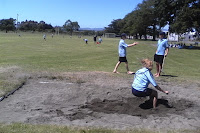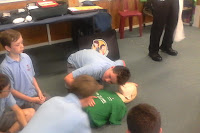Today we went down to Card Reserve with Room 3 and Room 4 to practise throws, sprints and long jump. We then practised high jump in the afternoon at school. I was very impressed with the huge amount of effort every Room 5 student put into their athletics today, and I can't wait to see what they can do at the Cluster Athletics on Monday. Hopefully the weather conditions are as perfect then as they were today.
Thursday, 5 November 2015
Athletics
The excitement is mounting as Athletics Day looms!
Today we went down to Card Reserve with Room 3 and Room 4 to practise throws, sprints and long jump. We then practised high jump in the afternoon at school. I was very impressed with the huge amount of effort every Room 5 student put into their athletics today, and I can't wait to see what they can do at the Cluster Athletics on Monday. Hopefully the weather conditions are as perfect then as they were today.
Today we went down to Card Reserve with Room 3 and Room 4 to practise throws, sprints and long jump. We then practised high jump in the afternoon at school. I was very impressed with the huge amount of effort every Room 5 student put into their athletics today, and I can't wait to see what they can do at the Cluster Athletics on Monday. Hopefully the weather conditions are as perfect then as they were today.
Tuesday, 3 November 2015
St John's Visit
 Daniel from St John visited St Teresa's in Week 4 to teach the students about first aide. In Room 5, this lesson was around performing CPR. The students learned about the steps to go through when you see someone is hurt. These steps are the DRS ABC.
Daniel from St John visited St Teresa's in Week 4 to teach the students about first aide. In Room 5, this lesson was around performing CPR. The students learned about the steps to go through when you see someone is hurt. These steps are the DRS ABC.Danger: Check for dangers before rushing to someone's aide. If we skip this step, we could injure ourselves and no longer be able to help the other person.
Response: Check to see if the person is responsive by asking if they can hear you. If you do not get a response initially, gently shake the person's shoulder while asking the same question.

Send for help: Send someone to get the help you need - whether it be an ice pack, a plaster, or an ambulance. Always make sure they come back to you so know they have done what you asked.
Airway: Tilt the injured person's head back, lift their chin, and gently open their mouth to ensure their airway is open and clear.
Breathing: Check to see if the injured person is breathing by listening for breaths and watching for the rise and fall of their stomach. Do this for 10 seconds. If the injured person is breathing, place them in the recovery position and monitor them until help arrives.
CPR: If the person is not breathing, begin CPR. Place one hand in the center of the person's chest (using their armpit as a guide), and the other hand on top. Press down with the heel of your hand 30 times (to the song Row, Row, Row Your Boat twice through). After that, give two breaths while blocking the injured persons nose, then continue compression.
Room 5 practiced giving CPR on a manikin, and learned about the dangers of performing compressions to a person who is not injured, and is still alive. This could confuse their heart and cause it to stop.
Plug, Wrap, Lift: The students then learned how to treat someone who is bleeding profusely by plugging the hole, wrapping it tightly, and elevating it. This will help reduce the flow of blood until the ambulance reaches them, or they can get to the hospital.
The students then had the opportunity to look around the ambulance.
They now feel more confident to help if they were with someone who was injured.
Thank you St John's for providing us with this great learning experience.
Subscribe to:
Comments (Atom)


































